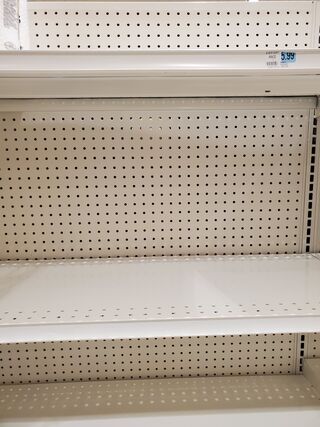Anxiety
Is COVID-19 Producing Widespread Hoarding Disorder?
Experts explain what’s really going on.
Posted December 28, 2020

Last spring when the COVID-19 pandemic began, people rushed to grocery stores to buy canned goods, disinfectant, paper towels, and toilet paper. Facing empty shelves in local stores, many of us wondered what was going on. Now it’s happening again. Since Thanksgiving, I’ve seen the same empty shelves, the same shortages of paper towels and toilet paper.
While walking my dog last week, I noticed that my neighbor’s garage door was open. Inside were stacks and stacks of toilet paper reaching almost to the ceiling. Is this hoarding disorder?
Hoarding disorder differs from normal buying and collecting. The Diagnostic and Statistical Manual of Mental Disorders, or DSM-5, defines it as:
persistent difficulty discarding or parting with possessions, regardless of their actual value, as a result of a strong perceived need to save the items and to distress associated with discarding them. ... Symptoms of hoarding disorder result in the accumulation of a large number of possessions that congest and clutter active living areas to the extent that their intended use is substantially compromised (American Psychiatric Association, 2013, p. 236).
Emotionally attached to their possessions and unable to let them go, people with hoarding disorder accumulate stacks of newspapers, magazines, piles of old clothes, plastic bags, and junk mail. In extreme cases, their homes become so cluttered that they are unable to cook in their kitchens or sleep in their beds. Their unsafe living conditions lead to accidents, pest infestations, and house fires.

But the current wave of panic buying is different. People are not so much holding onto things as rushing to buy things for fear of running out. To understand what is going on, I approached two of my colleagues in the Psychology Department at Santa Clara University.
Santa Clara psychologist Tom Plante differentiates between panic buying and hoarding behavior. “I think people act on fear,” he says. “They circle the wagons, and social comparison theory suggests that if they see their friends and neighbors doing panic buying then maybe they should too. A run on any product makes it more desirable."
This panic buying could be a reaction to all the negative news, according to Santa Clara psychologist Birgit Koopmann-Holm. “There’s just so much negativity with death and losing jobs,” she says, explaining that panic buying is one way people are trying to regain control in a world that seems suddenly threatening, uncertain, and chaotic (Vainshtein, Nov 25, 2020).
Florida psychiatrist Carol Mathews points out major differences between panic buying, stockpiling, and hoarding disorder. As director of the Center for OCD, Anxiety and Related Disorders at the University of Florida, Dr. Mathews sees hoarding disorder as not so much a case of excessive buying but “the difficulty in discarding what’s no longer needed.” She emphasizes that it’s a serious psychological condition that affects over 13 million Americans (Mathews, 2020).
Mathews sees stockpiling as a natural form of preparation and planning practiced by people who stock up on canned goods and wood for fireplaces to prepare for the winter. But stockpiling, she says, can become extreme when “during a crisis, it can lead to national shortages of essential items.” And, as Tom Plante points out, the more people hear of panic-driven stockpiling in the news, the more they are triggered to buy more of what they consider essential for their survival.
According to Mathews, the current wave of panic buying “is an impulsive and temporary reaction to anxiety caused by an impending crisis” (Mathews, 2020). Driven by fear, people rush to buy what they consider essential in a desperate struggle for survival.
Here’s the important distinction: While stockpiling involves normal planning for the future, both panic buying and hoarding disorder are driven by fear and reflect emotional distress.
If you or someone you know is compulsively buying or hoarding, it could help to consult with a therapist or professional health care provider to overcome these fears and regain a more balanced approach to life.
This post is for informational purposes and should not substitute for psychotherapy with a qualified professional.
References
American Psychiatric Association. (2013). DSM-5: Diagnostic and statistical manual of mental disorders. 5th Edition. Arlington, VA: American Psychiatric Association.
Koopmann-Holm, B. quoted in Vainshtein, A. (2020, November 25). We shouldn’t be panic buying again in the Bay Area, but some are. Experts explain why. San Francisco Chronicle. https://www.sfchronicle.com/business/article/We-shouldn-t-be-panic-buying-again-in-the-Bay-15752384.php
Mathews, C. A. (2020, November 30). Hoarding, stockpiling, panic buying: What’s normal behavior in an abnormal time? Anxiety and Depression Association of America. https://adaa.org/learn-from-us/from-the-experts/blog-posts/consumer/hoarding-stockpiling-panic-buying-whats-normal
Plante, T. (2020). Personal communication, December 11, 2020.




